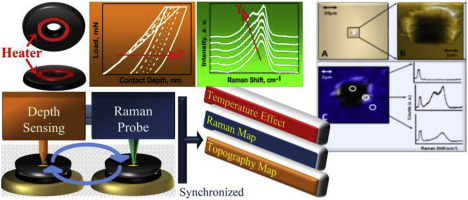Our official English website, www.x-mol.net, welcomes your
feedback! (Note: you will need to create a separate account there.)
In-situ thermal stability analysis of amorphous carbon films with different sp 3 content
Carbon ( IF 10.5 ) Pub Date : 2018-04-01 , DOI: 10.1016/j.carbon.2018.01.034 Mehdi Rouhani , Franklin Chau-Nan Hong , Yeau-Ren Jeng
Carbon ( IF 10.5 ) Pub Date : 2018-04-01 , DOI: 10.1016/j.carbon.2018.01.034 Mehdi Rouhani , Franklin Chau-Nan Hong , Yeau-Ren Jeng

|
Abstract A synchronized system integrating Raman spectroscopy and depth-sensing techniques was applied to analyze the microstructure, mechanical properties and surface roughness of amorphous carbon (a-C) films in-situ. This integrated system equipped with a high-temperature chamber coupled with feedback control made it possible to study the temperature effects on the mechanical properties and the microstructure of the films. A series of a-C films with different sp3 content were deposited on Si substrates using a filtered cathodic arc vacuum (FCVA) deposition system. Our study confirms previous results that the thermal stability of the a-C films depends on their sp3 content. The results also show that the structural change is accompanied by a significant increase in the surface roughness. This synchronized characterization technique demonstrates that the film hardness decreases with temperature even before any chemical changes detected using Raman spectroscopy. Moreover, the surface of the films is more sensitive to the temperature compared to the bulk as evidenced by the surface roughness characterization, showing that the surface roughness starts to rise at temperatures lower than for the onset of structural transition in the bulk. Nanoscratch and nanowear tests further support the conclusion that the surface sensitivity to temperature is greater than for the bulk.
中文翻译:

不同sp 3 含量非晶碳薄膜的原位热稳定性分析
摘要 应用集成拉曼光谱和深度传感技术的同步系统原位分析非晶碳(aC)薄膜的微观结构、机械性能和表面粗糙度。这种配备有高温室和反馈控制的集成系统使得研究温度对薄膜机械性能和微观结构的影响成为可能。使用过滤阴极电弧真空 (FCVA) 沉积系统在 Si 基板上沉积一系列具有不同 sp3 含量的 aC 薄膜。我们的研究证实了先前的结果,即 aC 薄膜的热稳定性取决于它们的 sp3 含量。结果还表明,结构变化伴随着表面粗糙度的显着增加。这种同步表征技术表明,即使在使用拉曼光谱检测到任何化学变化之前,薄膜硬度也会随温度降低。此外,与本体相比,薄膜表面对温度更敏感,如表面粗糙度表征所证明的那样,表明表面粗糙度在低于本体结构转变开始的温度下开始上升。纳米划痕和纳米磨损测试进一步支持表面对温度的敏感性高于块体的结论。表明表面粗糙度在低于本体结构转变开始的温度下开始升高。纳米划痕和纳米磨损测试进一步支持表面对温度的敏感性高于块体的结论。表明表面粗糙度在低于本体结构转变开始的温度下开始升高。纳米划痕和纳米磨损测试进一步支持表面对温度的敏感性高于块体的结论。
更新日期:2018-04-01
中文翻译:

不同sp 3 含量非晶碳薄膜的原位热稳定性分析
摘要 应用集成拉曼光谱和深度传感技术的同步系统原位分析非晶碳(aC)薄膜的微观结构、机械性能和表面粗糙度。这种配备有高温室和反馈控制的集成系统使得研究温度对薄膜机械性能和微观结构的影响成为可能。使用过滤阴极电弧真空 (FCVA) 沉积系统在 Si 基板上沉积一系列具有不同 sp3 含量的 aC 薄膜。我们的研究证实了先前的结果,即 aC 薄膜的热稳定性取决于它们的 sp3 含量。结果还表明,结构变化伴随着表面粗糙度的显着增加。这种同步表征技术表明,即使在使用拉曼光谱检测到任何化学变化之前,薄膜硬度也会随温度降低。此外,与本体相比,薄膜表面对温度更敏感,如表面粗糙度表征所证明的那样,表明表面粗糙度在低于本体结构转变开始的温度下开始上升。纳米划痕和纳米磨损测试进一步支持表面对温度的敏感性高于块体的结论。表明表面粗糙度在低于本体结构转变开始的温度下开始升高。纳米划痕和纳米磨损测试进一步支持表面对温度的敏感性高于块体的结论。表明表面粗糙度在低于本体结构转变开始的温度下开始升高。纳米划痕和纳米磨损测试进一步支持表面对温度的敏感性高于块体的结论。











































 京公网安备 11010802027423号
京公网安备 11010802027423号